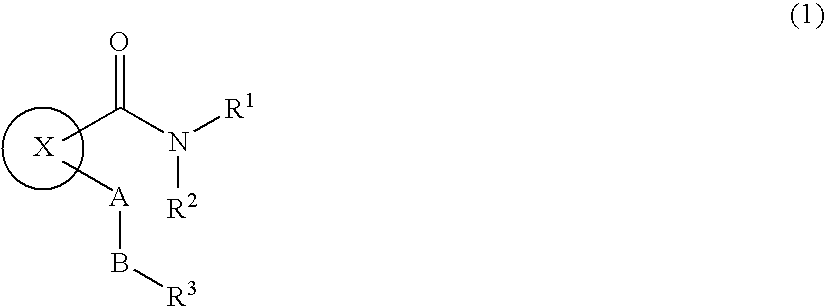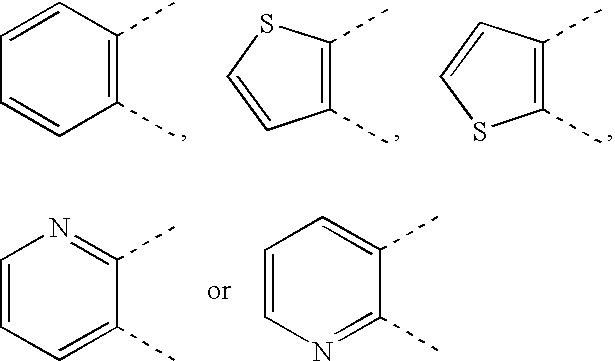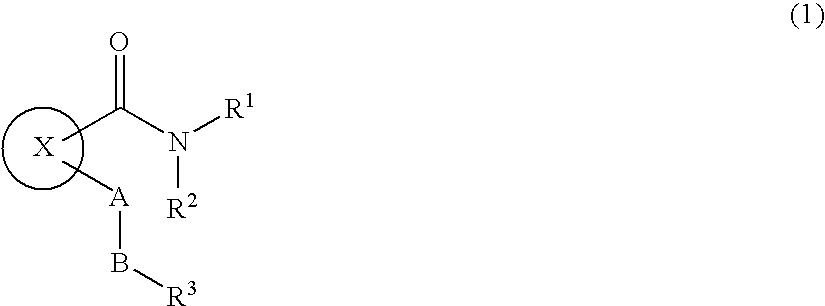Novel cyclic compound having quinolylalkylthio group
a technology of cyclic compounds and quinolylalkyl groups, which is applied in the field of new cyclic compounds having quinolylalkylalkyl groups, can solve the problem of no description of cyclic compounds having quinolylalkylalkylalkylalkyl groups, and achieve excellent antiangiogenic
- Summary
- Abstract
- Description
- Claims
- Application Information
AI Technical Summary
Benefits of technology
Problems solved by technology
Method used
Image
Examples
production examples
Reference Example 1
6,7-Dimethoxy-4-methylquinoline (Reference Compound No. 1-1)
[0149] The Reference Compound No. 1-1 was prepared following the method described in J. Org. Chem., 62, 568-577 (1997). Namely, iron (III) chloride hexahydrate (5.7 g, 21 mmol) and 3,4-dimethoxyaniline (3.1 g, 20 mmol) were added to acetic acid (60 mL), and then the mixture was stirred at 60° C. After all the solids were dissolved, methylvinylketone (1.8 mL, 22 mmol) was added dropwise for 5 minutes. Then the mixture was stirred at 140° C. for 1 hour, and allowed to cool down to room temperature, and the resulting solid was filtered off. Ethyl acetate (200 mL) was added to the solid, and the resulting organic solution was washed with 0.1N sodium hydroxide aqueous solution (200 mL) and brine (100 mL), and dried over anhydrous magnesium sulfate. The solvent was evaporated under reduced pressure, and the resulting solid was filtered off with diethyl ether to give 1.6 g of the title reference compound as a ...
reference example 2
6,7-Dichloro-4-formylquinoline (Reference compound No. 2-1)
[0157] Trifluoroacetic acid (360>L, 4.7 mmol), tert-butyl iodide (450>L, 3.8 mmol), iodine (990 mg, 3.9 mmol) and iron(II) chloride tetrahydrate (170 mg, 0.85 mmol) were added sequentially to a solution of 6,7-dichloro-4-methylquinoline (Reference compound No. 1-2, 790 mg, 3.7 mmol) in dimethylsulfoxide (18 mL) at room temperature, and the mixture was stirred at 80° C. for 7 hours. Then saturated sodium thiosulfate aqueous solution (100 mL) was added, and then ethyl acetate (300 mL) and saturated aqueous sodium hydrogencarbonate solution (200 mL) were added thereto. The mixture was separated into the organic layer and the aqueous layer, and the organic layer was washed with saturated brine (100 mL), dried over anhydrous magnesium sulfate, The solvent was evaporated under reduced pressure to give 840 mg of the title reference compound as a brown solid (Yield: 99%).
[0158]1H-NMR (400 MHz, DMSO-d6)
[0159]δ 8.14 (d, J=4.4 Hz, ...
reference example 3
4-(Hydroxymethyl)quinoline (Reference Compound No. 3-1)
[0165] A solution of 4-quinolinecarboxylaldehyde (20 g, 130 mmol) in anhydrous tetrahydrofuran (200 mL) was added dropwise for 30 minutes to a suspension of sodium borohydride (5.3 g, 140 mmol) in anhydrous tetrahydrofuran (300 mL) under ice-cooling, and the mixture was stirred for 1 hour at room temperature. Water (300 mL) was added to the mixture, and the whole was then extracted with ethyl acetate (400 mL×once, 100 mL×three times) The organic layer was washed with brine (200 mL×3 times) and dried over anhydrous magnesium sulfate. The solvent was evaporated under reduced pressure, and the resulting solid was filtered off with diethyl ether and washed to give 14 g of the title Reference Compound as an orange-white solid (Yield: 69%)
[0166]1H-NMR (500 MHz, DMSO-d6)
[0167]δ 5.04 (dd, J=5.5, 0.9 Hz, 2H), 5.57 (t, J=5.5 Hz, 1H), 7.57-7.63 (m, 2H), 7.76 (m, 1H), 8.02-8.06 (m, 2H), 8.70 (d, J=4.3 Hz, 1H)
[0168] As described below, ...
PUM
| Property | Measurement | Unit |
|---|---|---|
| temperature | aaaaa | aaaaa |
| temperature | aaaaa | aaaaa |
| temperature | aaaaa | aaaaa |
Abstract
Description
Claims
Application Information
 Login to View More
Login to View More - R&D
- Intellectual Property
- Life Sciences
- Materials
- Tech Scout
- Unparalleled Data Quality
- Higher Quality Content
- 60% Fewer Hallucinations
Browse by: Latest US Patents, China's latest patents, Technical Efficacy Thesaurus, Application Domain, Technology Topic, Popular Technical Reports.
© 2025 PatSnap. All rights reserved.Legal|Privacy policy|Modern Slavery Act Transparency Statement|Sitemap|About US| Contact US: help@patsnap.com



